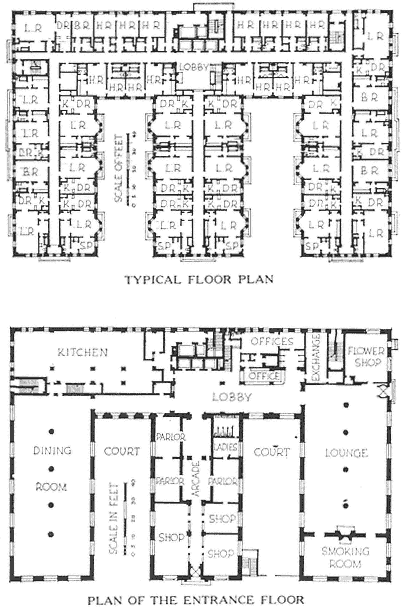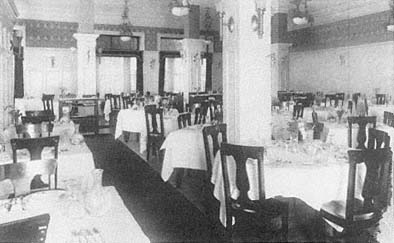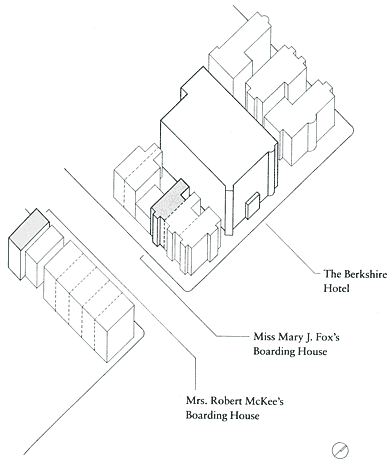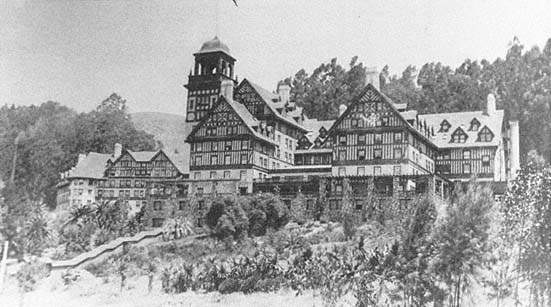Variations of the Midpriced Hotel
If a young business person of moderate means hoped to rub shoulders with upper-class investors, his or her most logical choice of a hotel home would not have been living in a midpriced enterprise at all but rather renting a back hall room at a palace hotel. Few palace hotels could be as imperious as Boston's old Tremont House, which charged only one high rate. Prices usually varied widely. Jefferson Williamson notes that before the Civil War the grandest hotels—those advertising prices of $2 a day for board and room—offered "in profusion" 50-cent or $1 accommodations for lesser rooms.[55] As hotel owners installed indoor plumbing, prices of rooms with a private bath could be two and a half times greater than rooms in the same hotel but with a shared bath down the hall. Hotel architects relegated such rooms to areas along alley walls, in noisy corners of the building where the only light came from narrow air shafts, or where the occupants would have no view (fig. 3.15). In the 1920s, managers at the Chicago Beach Hotel on Lake Michigan charged a middle-income rate of $56 a month for a room without bath in an old wing built in the 1890s; meanwhile, lakeview suites in the newest section started at a princely rate of $700 a month.[56] Even the lower-priced rooms at a palace hotel had the advantages of service, public rooms, and general prestige. But they betrayed themselves in social engagements. "No, don't bother to come by our rooms, we'll meet you in the lobby," was the refrain of back hall hotel residents. Middle-income residents could also locate their hotel home in a palace hotel that had fallen slightly from social grace, thanks to the real estate process known as filtering. If palace hotel tourists shifted to a more fashionable hotel, the rents in the older building usually dropped into a range affordable at middle-income levels.
Small hotels at the lower end of the midprice rank hung on to their social class respectability with difficulty, and their amenities sometimes ranged precariously close to their poor relatives, the rooming houses. To qualify socially for residents of middle income, even the smallest

Figure 3.15
Plans for the ground floor and a typical upper floor of the Hotel
Pennsylvania, Philadelphia, published in 1924. Single hotel rooms
are at the back, suites at the front. Unusual room labels include
H.R . for single hotel rooms and S.P . for sleeping porches.
Most living rooms have Murphy beds.
hotel had to have a lobby and a dining room on the ground floor (fig. 3.16). For the smallest midpriced hotels, architects tucked cafés or dining rooms into the back of the building, under skylights at the bottom of light wells, or into reasonably well lighted basements. Better room furnishings, more unctuous staff, and having an elevator also helped to distinguish small midpriced hotel buildings from mere rooming houses.[57]

Figure 3.16
The dining room of San Francisco's Hotel Cecil. With a fairly low ceiling
and awkwardly placed columns, this dining room was architecturally
a step down from the dining room of the Delmonico Hotel but
still proper for middle-income patrons on a tight budget.
These smaller hotels descended from the long nineteenth-century tradition of respectable boardinghouses—single-family houses converted to commercial housing use. To attract people with polite middle-income pretensions, either the food offered or the architecture of the original house had to be quite grand. Two San Francisco houses in the lower Nob Hill area, both converted to boarding operations by the 1880s, show the edge of social propriety (fig. 3.17). Miss Mary J. Fox and Mrs. Robert McKee rented out rooms or suites of rooms in their modest houses on Post Street near Jones. They borrowed social sheen from the much larger houses a block uphill to the north, on Sutter Street. Behind Miss Fox's house loomed a new building, the Berkshire family hotel, a four-story brick building with an elevator (a luxury feature for a hotel of its size at that time). Early insurance records simply called the Berkshire a private hotel, but it was one of the city's best family hotels, the fourth largest one opened in the city. Like the small converted houses nearby, the Berkshire was managed by a woman. By 1900, because of the built-in amenities in structures like the Berkshire, only if a single-family house were very large and opulent, perhaps built by a well-known family, could the owners convert it and charge middle-income rates.[58]
Beginning in the 1880s and continuing through World War I, real estate speculators also experimented with midpriced hotels in the suburbs. In a large and proper suburban area, developers often included

Figure 3.17
Axonometric drawing of a lower Nob Hill neighborhood in San Francisco,
1885. Single-family houses are mixed with boardinghouses (shaded)
and the Berkshire, an expensive residential hotel with an elevator.
a snowy hotel—part real estate office, part residential building, part country club. In the San Francisco region, the Claremont Hotel is a quintessential example (fig. 3.18). It opened in 1915 on a wooded site with a creek and sixteen acres of gardens at a prominent overlook at the end of a major interurban transit line. Naturally, the land development company itself developed the rail line and advertised their hotel as "five minutes from Berkeley, fifteen minutes from Oakland, a half-hour from San Francisco." Two hundred rooms, half with baths, were in a 700-foot-long wooden building with 500 linear feet of porches looking out over a spectacular view of the hills, the bay, and San Francisco. Streetcars and carriages entered on one side, where there were also large stables; automobiles had a separate porte cochere and garage on the other side.[59] Below the hotel on three sides were devel-

Figure 3.18
The Claremont Hotel in Oakland, California, a classic example of a suburban resort and residential
hotel, opened in 1915. It was located at the end of an interurban line from San Francisco and was
surrounded by expensive house lots.
opments of substantial new suburban houses for the middle and upper class. The residents of these houses were expected to be frequent diners at the hotel.
Other suburban midpriced resort hotels were on beachfronts, lakesides, or hilly wooded lots along a stream. Some country clubs also had sleeping rooms, eventually used permanently. Yet after 1920, as a result of zoning restrictions and suburban market realities, further developments of such outposts of urbane commercial life were to be overwhelmed by garden apartments and rules prohibiting the mixture of uses that the Claremont Hotel meant for its surrounding neighborhood.